Get Your Telescopes Ready: Neptune Is Coming

The Solar System’s outermost, undisputed planet wasn’t discovered until the 19th century. Here’s how you can easily find it yourself this December.
There’s no greater scientific thrill than discovering something brand new for the very first time. For millennia, humanity knew of only five planets in the sky: Mercury, Venus, Mars, Jupiter and Saturn. The reason? They’re the only planets easily visible with the naked eye. As time went on, we realized that there was a sixth, as Earth was a planet as well, all of which orbited the Sun. In 1781, a serendipitous discovery by William Herschel heralded the 7th planet: Uranus. After perhaps 60 years of observation, anomalies in its orbit let to the proposal that a new, outer planet must exist to cause this odd gravitational behavior. Lo and behold, in 1846, within a single degree of the predicted location by theorist Urbain Le Verrier, the 8th and final planet, Neptune, was found.

As far as we know, that’s it for our Solar System, although many other interesting moons, dwarf planets, asteroids and Kuiper belt objects certainly exist in great abundance here. What’s perhaps remarkable is that Neptune, despite being 30 times as far away from the Sun as Earth is, is visible with even the most primitive telescope you can find, if you know where to look.
We know this because way back in the early 1600s, just a few years after Galileo first pointed his telescope skyward, he recorded a “star” that shouldn’t have been there while viewing the moons of Jupiter.
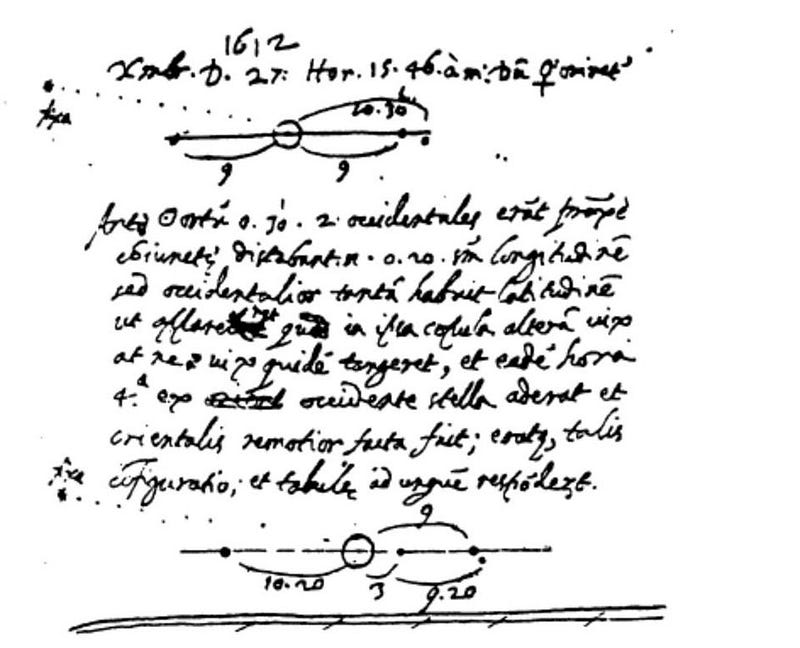
On the night of December 27th, 1612, Galileo was observing Jupiter and two of its large moons: Ganymede (left) and Europa (right). A little farther to the right and slightly below Europa is another of Jupiter’s moons, Callisto, but far off to the left is another star-like object that he made a special note of, calling it a “fixed star” in his notes.
Simulating the Solar System, as we know it today, we can clearly identify what objects were where on that night. By about 2 AM the next morning, December 28th, the moons of Jupiter would have lines up almost exactly as Galileo had recorded them from his location in Italy. There would have been a 7th-magnitude star just slightly above the Europa/Callisto duet, but there also would have been a strange, faint blue one of 8th magnitude.
That bluish background star, though, was no star at all, but rather the 8th planet in our Solar System: Neptune.
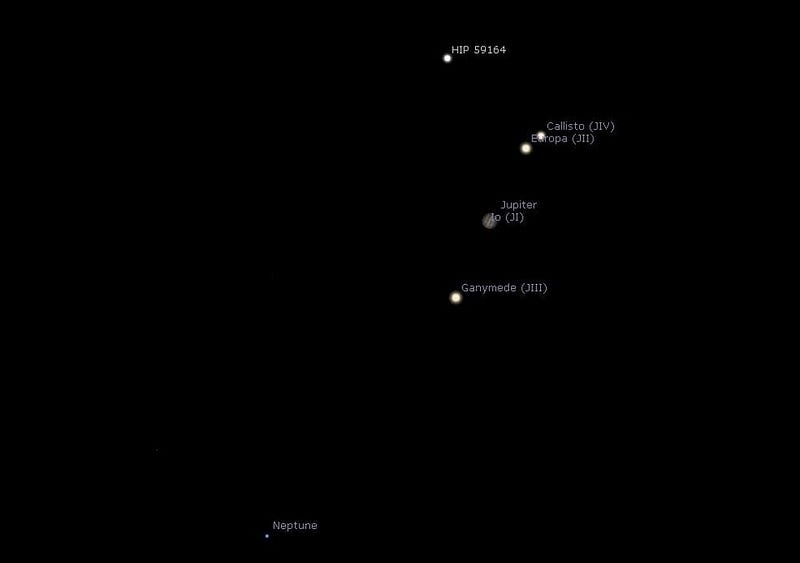
Because it’s not visible without an aid, like very good binoculars or a telescope, you must know exactly where and when to look to find Neptune if you want to have a good chance of seeing it. It’s a planet, not a star or deep-sky object, so it changes position dramatically from night-to-night and year-to-year.
While there are some very good pieces of software out there that will help you identify its location at any given time, it’s still a severe challenge for an inexperienced skywatcher.
But the common, naked-eye objects, like bright stars and planets, are easy to find. And one of the brightest objects that’s been gracing the night sky all summer and fall long, Mars, is still shining bright in the post-sunset sky.
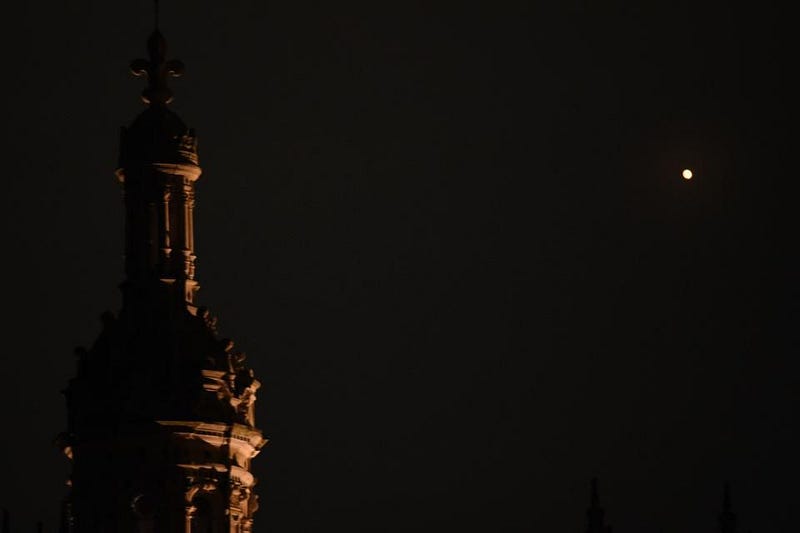
On a few occasions every year, the planets, as viewed from Earth, make close passes to one another, known as conjunctions. Even more rarely, the planets will actually appear to overlap in the sky, where the nearer planet passes in front of the farther one, causing an occultation. Although Galileo observed Neptune and Jupiter very close to a chance occultation that occurred a week later, in early 1613, there have been no planet-planet occultations in 200 years. (The next one occurs in 2065, when Venus occults Jupiter.)
However, conjunctions are much more common, and a spectacularly close pass will occur on December 7th between Mars and Neptune. Separated by a mere 0.03 degrees, these two planets will be visible in the same field-of-view through practically any binoculars or telescope.
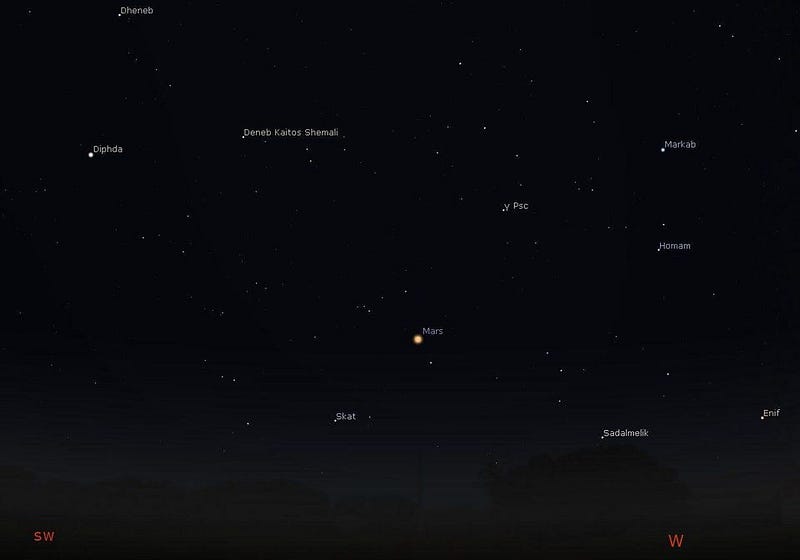
Mars will be the easiest planet to identify, appearing in the south/southwest portion of the sky after sunset, amidst the backdrop of stars shown above. Its unmistakable red color and clear, non-twinkling nature makes it stand out against every other object in the sky. As the sky rotates over the course of the night, it will remain visible until right around midnight throughout the world, when it should then set in the west.
But on December 7th, you’ll want to point your telescope (or binoculars) at Mars, and get as clear and stable a field-of-view as possible. If you can focus on Mars, as close to 14:40 Universal Time as possible, you should see a star field like the one below, with a small, blue dot close to Mars, approaching within that tiny fraction of a degree.
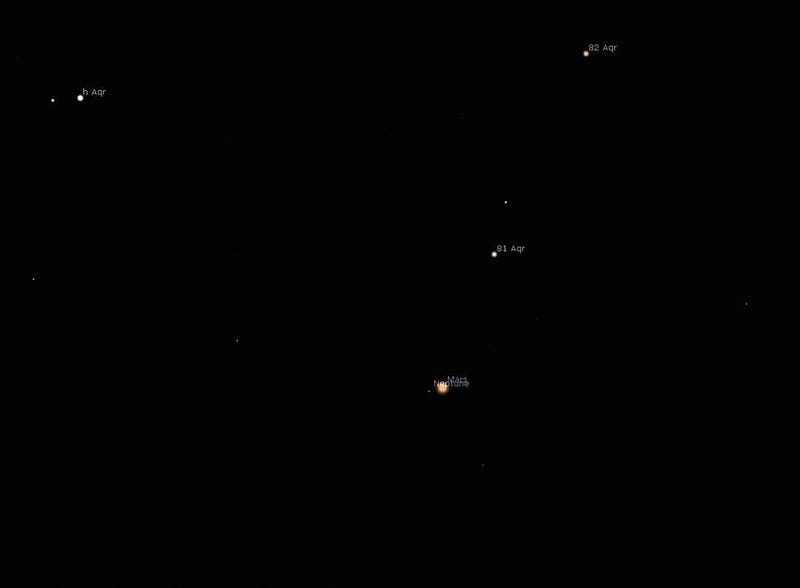
That blue, 8th magnitude dot?
That’s Neptune.
Most human beings will never get a chance to view Neptune with their own eyes, but this December 7th, nature is making it as easy as possible. While the best viewing is available to people living in Asia, Australia and eastern Europe/Africa, this spectacular blue planet will be visible, within half-a-degree of Mars, throughout the world on both the nights of December 6th and 7th.

Because of the periodic motions of the planets, Mars and Neptune had a close encounter just two years ago, but this year’s conjunction blows that one away in terms of proximity and viewing conditions. With a new Moon on December 7th, clear skies and the Geminid meteor shower growing towards its December 13th peak, it’s a great night to be outside for stargazing. Bring even a small telescope or a pair of binoculars with you, though, and the spectacular, blue sight of Neptune will be your reward.
For a few minutes of effort, you’ll see what no human prior to Galileo ever saw, except unlike Galileo, you won’t mistakenly record that you observed a fixed star. Instead, you’ll know you’re viewing the 8th and outermost planet in our Solar System, a planet that nobody knew existed a mere two centuries ago. This December 7th, we all have the opportunity to become astronomers. Make your chance count.
Ethan Siegel is the author of Beyond the Galaxy and Treknology. You can pre-order his third book, currently in development: the Encyclopaedia Cosmologica.





